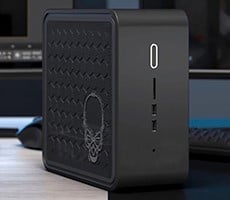Alienware Aurora R3 System Autopsy
Boutique system vendor Alienware hopes you'll choose the latter, and to help nudge you in that direction, the company sent its new Aurora R3 in search of life on Earth. It just so happens that one of these rigs crash landed at HotHardware, and today it's us performing the Alien(ware) autopsy on them. We dissected the Aurora R3 from head to toe, discovered what makes it tick, and then fed it a handful of games and other software to observe how it digests a diet of DirectX 11 and other modern morsels, all in the name of science, of course.
|
|
|
|
Model
|
Aurora R3 |
|
CPU
|
Intel Core i7 2600K; Alienware High-Performance CPU Liquid Cooling |
|
Memory
|
4GB DDR3 1333MHz (2 DIMMs) |
|
Graphics
|
2 x ATI Radeon HD 6950 (CrossFire) |
| Storage |
Seagate Barracuda XT 2TB 7200RPM (64MB, SATA 6Gbps) |
|
Optical
|
Blu-ray Reader/DVD Burner Combo |
| Operating System |
Windows 7 Home Premium x64 |
| Wired Internet |
10/100/1000 Ethernet |
|
Front Panel Ports
|
2 x USB 2.0; 1 x USB 3.0; Headphone and Mic |
|
Rear Panel Ports
|
6 x USB 2.0; 2 x USB 3.0; FireWire; GbE LAN; Audio Inputs; Optical SPDIF; Coaxial SPDIF; eSATA |
| Sound | Integrated 7.1 w/ THX TruStudio PC |
| Power Supply | 875W |
|
Weight
|
~45 pounds (average) |
| Keyboard / Mouse | Dell Studio |
|
Dimensions
|
9.847" x 25.39" x 16.77" (WxDxH) |
|
Warranty
|
1 Year Basic Service Plan |
|
Price
|
$2,448.99 (as configured) |
Pricing for the Aurora R3 starts at scant $1,200, and we say "scant" because premium system builders typically charge premium prices for their machines. We're well aware that Alienware was acquired by Dell five years ago, and while some PC gaming purists might still take issue with that, teaming up with a bulk OEM has made Alienware systems accessible to customers on a tighter budget, while still maintaining the DNA of a boutique system builder.
As configured, the Aurora R3 we received checks in at just shy of $2,450 before taxes and shipping. Along with the higher price tag comes a better selection of components, including an Intel Core i7 2600K processor (liquid cooled) running the show, a pair of AMD Radeon HD 6950 graphics cards with double the appetite for gaming goodness, and a Blu-ray reader. Our system didn't ship with a solid state drive, and 4GB of DDR3-1333 is rather pedestrian for an Alienware system, but it does come with a SATA 6Gbps hard drive with 64MB of cache, an 875W power supply, and USB 3.0 ports found on both the front panel and rear I/O ports.






